Firefighters at Greenville-Spartanburg International Airport (GSP) are thrilled with the new aircraft rescue and firefighting (ARFF) station they moved into last November. At 24,000 square feet, the facility is triple the size of the previous station, and also includes updated features and comforts for crews and equipment.
Firefighters at Greenville-Spartanburg International Airport (GSP) are thrilled with the new aircraft rescue and firefighting (ARFF) station they moved into last November. At 24,000 square feet, the facility is triple the size of the previous station, and also includes updated features and comforts for crews and equipment.
 Even though the old station was remodeled in the mid-1980s, size was still a problem. “Everyone knew we had to get bigger,” says GSP Fire Chief Tony Lohrman.
Even though the old station was remodeled in the mid-1980s, size was still a problem. “Everyone knew we had to get bigger,” says GSP Fire Chief Tony Lohrman.
When the original station was built in 1962, the airport had just one pumper truck and one paid firefighter who was supported by several volunteers. These days, GSP has 23 state-certified aircraft and rescue firefighters who work 24-hour shifts and use 10 trucks and other pieces of equipment to accomplish their missions. (See Page 59 for a complete list.)
|
facts&figures Project: New Aircraft Rescue & Firefighting Station Location: Greenville-Spartanburg (SC) Int’l Airport Size: 24,000 sq. ft. Cost: $9 million for station; $1.4 million for 2 new Rosenbauer Panther vehicles Funding for ARFF Station: 65% Airport Improvement Program, 35% airport funds Funding for Firetrucks: 90% Airport Improvement Program, 10% airport funds Construction: Nov. 2019-Dec. 2020 Personnel: 23 firefighters working 24 hours on/48 hours off
Equipment: 2 Rosenbauer Panthers; 4×4 E-One Titan; Pierce Contender; foam trailer; Dodge Durango pickup; Chevy Silverado truck; custom-built International vehicle; Ford F250 & F150 trucks; Architect of Record: LEO A DALY
Associate Architect:
Site Design & Project Management:
General Contractor: Construction Materials Testing: S&ME Electrical: H&W Electrical Corp. HVAC: B&K Services Inc. Plumbing: Donbuss Plumbing LLC Fire Sprinkler: A&A Fire Protection Sitework: Bishop Mays Inc.
Wash Unit for Personal Protective Equipment: Personal Protective Equipment Dryer & Gear Racks: Ready Rack High-Speed Doors: Rytec Corp. Apparatus Bay Fans: Big Ass Fans Apparatus Bay Air Filtration Units: Airhawk Air Purification Systems Alert System: Zetron Of Note: New station is 3 times larger than previous facility, which was built in 1962 when airport originally opened |
“With the bigger crash trucks and increased manpower, over time the infrastructure just wasn’t able to support our needs,” Lohrman explains. “We had everybody piled on bunkbeds in a single 10-foot-by-15-foot bunkroom supported by two bathrooms, one shower, and no locks on the doors.”
The new station was designed to be more of a home away from home for crews—with 10 single-person bunkrooms (each 100 square feet) and five unisex bathrooms with showers. “Our firefighters refer to it as their Taj Mahal,” Lohrman quips.
The $9 million station was funded at approximately 65% by Airport Improvement Program funds, with the remainder drawn from airport funds.
Big Station for Big Responsibilities
The station’s 9,000-square-foot apparatus bay alone is bigger than the entire old station. It has five drive-through bays for a foam trailer and 10 vehicles from various manufacturers, including two new 1,500-gallon Rosenbauer Panthers that recently replaced an Oshkosh Striker and E-One Titan. A positive-pressure HVAC system keeps contaminants from the apparatus bays out of the living quarters, and Airhawk Air Purification Systems scrub and filter the air in the bays.
High-speed doors from Rytec open in three seconds, making it possible for at least one ARFF vehicle to reach the midpoint of the runway and discharge agent within three minutes of a call as required by the FAA. Other vehicles and apparatus are capable of arriving and discharging agent within the required four minutes.
“We are responsible for 3,700 acres of airport property, including the terminal, airfield, roadways, buildings and undeveloped land,” Lohrman informs.
In addition, GSP is designated as a Special Purpose District, which allows its firefighters to respond to off-property fires and emergencies in the Greenville-Spartanburg area. Typical off-airport calls include structure fires, vehicle accidents, gasoline tanker fires, warehouse fires and other related emergencies that may require crash trucks with foam capabilities. In return, if GSP needs additional assistance at the airport, they receive mutual aid from community fire departments.
Lohrman estimates that GSP emergency crews respond to vehicle accidents on nearby interstates and highways two to three times a week. “We also get a lot of medical diverts from outside flights that have to land for medical emergencies,” he adds.
Efficiency & Comfort
Because the ARFF station responds to emergencies on and off the airport, it was important for designers to provide both airside and landside access for emergency vehicles and equipment. The parcel of land available for development, however, didn’t make that easy for WK Dickson, the firm providing site design services (and also project management).

“The site was constrained but had to match existing grades on three sides while providing direct access to and from both the airside and landside,” explains WK Dickson Vice President and Director of Aviation Services Paul Smith. “In addition, the soils evaluation completed for the site prior to design indicated that portions of the site were comprised of pockets of loose fill material placed on the site unknowingly many years ago. In some areas, these near surface soils were potentially on top of loose, uncompacted underlying soils. To account for these areas, the engineering team developed a remove/replace strategy to replace any encountered soft spots with proper backfill material, compacted to specific density requirements.”
To stabilize the building site and prevent foundation settlement issues, engineers from WK Dickson specified over-excavation and a 2-foot replacement of in-situ soils for the building and pavement footprints.
When designing the building, a team led by LEO A DALY focused on situating the apparatus bays to optimize airfield access. Ultimately, designers settled on five drive-through bays, with five landside doors pointing toward the highway and five airside doors that are perpendicular to the airfield. The public has limited access to non-secure areas of the building. Firefighters and other airport personnel use secured doors to access secure areas of the building.
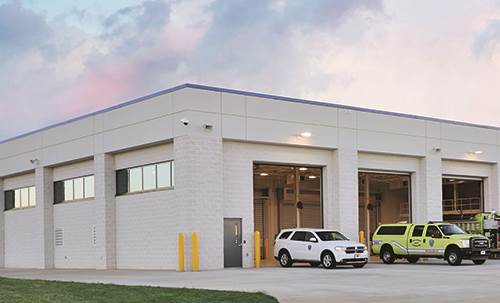
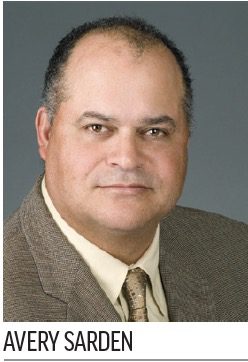 “The new ARFF [station] is better positioned closer to the middle of the runway and thus better able to respond quickly to emergencies on the runway and across the airport campus,” adds Avery Sarden, a vice president at LEO A DALY.
“The new ARFF [station] is better positioned closer to the middle of the runway and thus better able to respond quickly to emergencies on the runway and across the airport campus,” adds Avery Sarden, a vice president at LEO A DALY.
The station is divided into four areas:
- the public zone, which includes a lobby, training room, public restrooms and a breakroom;
- administrative offices, conference rooms and duty rooms;
- living quarters with a kitchen, dayroom, exercise room, dormitory rooms, bathrooms and showers; and
- firefighter work areas, including apparatus bays, support rooms, a decontamination room, laundry room and storage spaces.
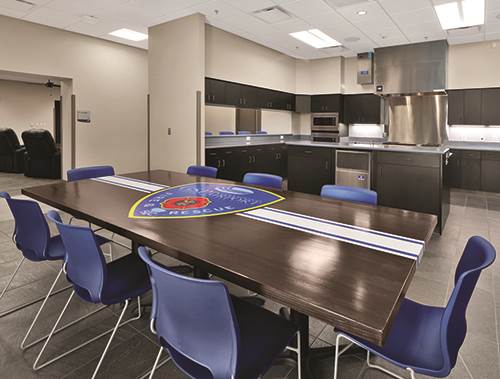
The kitchen facilities in the new station are much larger than those in the old building. “We went from a single refrigerator with no pantry to three refrigerators and three pantries,” says Lohrman, noting that firefighters no longer have to take their food home after each shift.
A 2,300-square-foot mezzanine at one end of the apparatus room has an open balcony with removable rails to allow for additional storage, rope and ladder work and a manhole opening for confined space and rescue exercises.
The training room also doubles as the airport’s emergency operations center. “It’s state-of-the-art,” Lohrman emphasizes. “We have two 86-inch TVs and a 55-inch touch-screen smart board with webcam. The room will accommodate 49 people. The area is public, so we can host events without having to worry about escorting people through secure areas of the station.”
 The living and administrative areas were designed to minimize response times from anywhere in the building. “The corridors look like a racetrack with the bathrooms and storage rooms on the interior and living areas and administrative offices on the exterior,” explains Michael Pry, a principal at DP3 Architects. “The private bunk rooms are equipped with LED red lights tied to the alert system to help reduce stress when firefighters are awakened during emergencies, and the individual dorm rooms and restrooms provide privacy and flexibility to create a true gender-neutral facility.”
The living and administrative areas were designed to minimize response times from anywhere in the building. “The corridors look like a racetrack with the bathrooms and storage rooms on the interior and living areas and administrative offices on the exterior,” explains Michael Pry, a principal at DP3 Architects. “The private bunk rooms are equipped with LED red lights tied to the alert system to help reduce stress when firefighters are awakened during emergencies, and the individual dorm rooms and restrooms provide privacy and flexibility to create a true gender-neutral facility.”
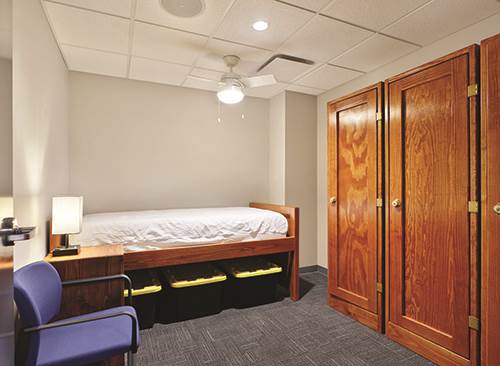
COVID Complications
The airport broke ground for its new ARFF station in November 2019. Contractors spent the first few months on structural and civil infrastructure work, and then the pandemic hit—just as walls were going up and crews needed to work inside.
 General contractor Mavin Construction responded by implementing strict COVID protocols and adapting to the ever-changing information about ways to prevent infection spread. “It was a very difficult challenge,” recalls Evan Pyle, the firm’s assistant project manager. “It affected all of our subcontractors, with regard to materials lead times, scheduling, social distancing. We had to work through all these issues.”
General contractor Mavin Construction responded by implementing strict COVID protocols and adapting to the ever-changing information about ways to prevent infection spread. “It was a very difficult challenge,” recalls Evan Pyle, the firm’s assistant project manager. “It affected all of our subcontractors, with regard to materials lead times, scheduling, social distancing. We had to work through all these issues.”
Mavin installed additional porta toilets and hand washing stations, and scoured the internet for cleaning supplies, masks and hand sanitizers. As a stopgap measure while waiting for shipments from China, the company purchased sanitizing products by the gallon from local companies and fashioned wipes to distribute at the jobsite.
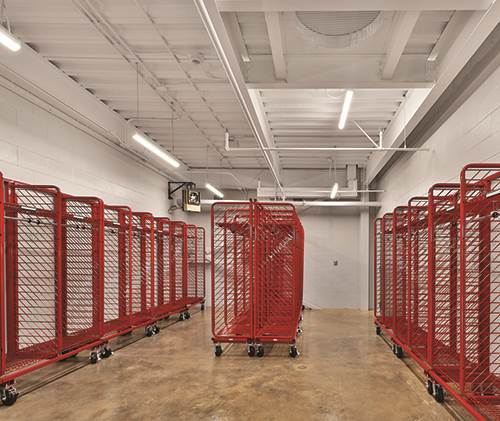

“Although it’s tough to segregate subcontractors within a work space, to the extent possible, we consolidated workers within their specific teams and required everyone to wear masks in the field,” Pyle explains. “We had a couple of positive COVID cases within the companies that were working on the project, but fortunately none of the workers onsite had interactions with them. In the end, we hit all of our critical dates and had a ribbon cutting in November 2020, the completion month originally scheduled by GSP. In normal times, we would have been concerned about rain delays. The pandemic made such concerns seem like peanuts in comparison.”
Matt Infanti, Mavin’s project manager, considers the project a big success. “It speaks volumes that despite the pandemic, we were able to move forward,” he says. “We’re grateful that the airport stuck with it. A lot of businesses shuttered up.”

|
New Panthers at Home in New Den
In April, Greenville-Spartanburg International Airport (GSP) took delivery of two brand new Rosenbauer Panther 4×4 ARFF vehicles. Each holds 1,500 gallons of water and 200 gallons of foam, and can discharge 1,000 gallons per minute from roof or bumper turrets. Fire Chief Tony Lohrman notes that the technologies included on the new vehicles are a significant step up for the airport. “The difference between these new trucks and the ones we are replacing is night and day,” he remarks. Importantly, the new vehicles are able to test and calibrate foam proportioning equipment without having to discharge foam onto the ground. “This is a major environmental concern facing airports today,” Lohrman explains. “These trucks are equipped with an internal testing device that allows us to calibrate the units to ensure they will discharge the correct amount of foam when emergencies occur.” [See July/August 2019 issue of Airport Improvement for more details about potential implications of discharging foam for testing purposes.]
The trucks cost $1.4 million and were funded at 90% by an Airport Improvement Program grant. Lohrman notes that purchasing two identical vehicles is beneficial for maintenance purposes and meeting FAA training requirements, but most of all, for keeping firefighters safe during high-risk operations when seconds count. |



 An auto-start feature helps reduce response times out of the station by allowing firefighters to start the vehicles from outside the trucks while donning their firefighting gear. A color camera with a digital video recorder provides operators with better scene views and captures video for potential follow-up investigations. “Safe to approach lights and a 360-degree camera system provides another level of scene safety by telling firefighters the truck cannot move and allowing the vehicle operator to monitor the entire area around the truck,” says Duane Kann, a regional sales manager for Rosenbauer America.
An auto-start feature helps reduce response times out of the station by allowing firefighters to start the vehicles from outside the trucks while donning their firefighting gear. A color camera with a digital video recorder provides operators with better scene views and captures video for potential follow-up investigations. “Safe to approach lights and a 360-degree camera system provides another level of scene safety by telling firefighters the truck cannot move and allowing the vehicle operator to monitor the entire area around the truck,” says Duane Kann, a regional sales manager for Rosenbauer America.

